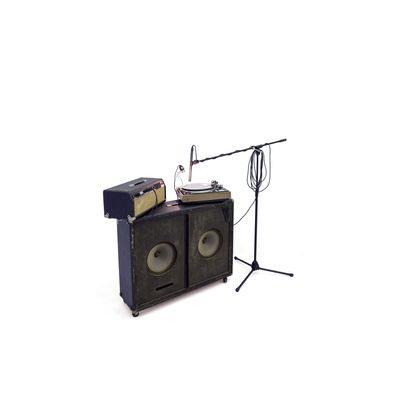
ItÔÇÖs been many decades since composers first started treating recorded noises like Play-DohÔÇökneading, doubling, and looping them; slowing them down and speeding them up; dressing them in all sorts of electronic disguises; and stitching them together with theater, film, photos, and architecture. Now that the manipulation of sound has long since passed through its experimental infancy into artistic maturity and on to commercial refinementÔÇöthatÔÇÖs when MoMA decides the time is ripe for its first exhibition dedicated to new frontiers in sound art. Leading from the rear.
ÔÇ£Soundings: A Contemporary Score,ÔÇØ organized by the museumÔÇÖs media-and-performance-art curator Barbara London, treats the genre as if it had just been born and John Cage had never lived. Half of the sixteen artists in the show are in their thirties, and their work is presented in contextless purity, gliding by virtually all the issues that sound art raisesÔÇöhow the brain infuses noise with meaning, how the ears perceive physical space, how natural and electronic sounds mingle, and how musicians and artists have wrestled with these phenomena in the past. Instead, ÔÇ£SoundingsÔÇØ is mostly a collection of hermetic mutterings.
The most effective installations are the simplest and most directÔÇöworks like Jana WinderenÔÇÖs Ultrafield, in which the songs of bats and fish, too high to hear, have been brought into audible range. Or like Richard GaretÔÇÖs Before Me, in which a marble spins in place on a turntable rotating at 331/3┬árpm, like a ball clattering in a roulette wheel that never slows. With its literal broken-record nostalgia for analog days, the piece is both wry and heartfelt. In a similarly wistful vein, Stephen Vitiello wandered around New York gathering bell soundsÔÇöclock-tower chimes, a dinerÔÇÖs dring-dring indicating that an order is ready, the warning gong on a Coney Island ride, school bells, dinner bells, doorbells, carriage bells, and so onÔÇöthen doling them out in the Sculpture Garden, one for every minute of the hour.
But these mild charmers get lost amid lumpy experiments by artists who donÔÇÖt seem to care how their sounds actually sound. In Microtonal Wall, Tristan Perich delves into the details of white noise, tiling a hallway with a grid of 1,500 tiny speakers, each one tuned to a different whistling tone. The work remains constant, an impassive array of buglike chirps. The viewer-listener produces the action: Stand back and you hear undifferentiated static; scoot along its length with one ear close to the wall and you get a wheezing glissando.
The difference between sound art and music, if there is one, is that it requires only as many minutes as youÔÇÖre content to give. Walk out of the gallery before the loop is over and youÔÇÖre not likely to miss the all-revealing climax. Time is an inescapable aspect, but not the principal conduit of experience. This fact yields a lot of drones. Jacob Kirkegaard snuck into the abandoned Chernobyl fallout zone and set up microphones in four abandoned rooms. He recorded and rerecorded the room toneÔÇöthe low, variable buzz thatÔÇÖs present in virtually every enclosed spaceÔÇömultiple times, piling the various takes into a loud, layered hum. ItÔÇÖs like listening closely to a session with a dental hygienist. Even so, the acoustical-ugliness prize goes to Haroon MirzaÔÇÖs Frame for a Painting, in which a string of color-┬¡shifting LEDs does indeed frame a Mondrian painting. A flashing bike light triggers a pair of aggressive electronic buzzers that make the viewer feel like a game-show contestant whose answers are always wrong.
Sound can be a visual medium, too, which is presumably why MoMA has claimed it. In Wellenwanne Ifo, Carsten Nicolai pipes inaudible sounds through a quartet of vibrating metal arms that graze a thin layer of water. Each impulse is a tiny pebble dropped in a shallow lake, and the ripples cross each other in silent counterpoint. ItÔÇÖs an awfully elaborate apparatus to illustrate the simple principle that sound and water move in similar waves, but at least it has a clear idea. ThatÔÇÖs not the case with Marco FusinatoÔÇÖs Mass Black Implosion, a desperately parasitical work that feeds on the score of Iannis XenakisÔÇÖs wildly expressive string orchestra piece Shaar. Fusinato has drawn a black line from every note on the page to a single central point, producing an impressively obsessive doodle of some big musical bang. Unfortunately, a vanishing point is no antidote for pointlessness.
Other peopleÔÇÖs creations are always a great resource when youÔÇÖre running low on imagination, but they can wither if you donÔÇÖt treat them well. Susan Philipsz does herself no favors by grinding the poignant relic of an appalling history into a collection of inexpressive musical dust. Her source is Pavel HaasÔÇÖs 1943 Study for Strings, written and performed in the Theresienstadt concentration camp just before the composer and most of the players were shipped to their deaths. Philipsz continues the subtraction by recording just the viola and cello parts in chopped-up bits, then distributing them on numerous channels, so that whatÔÇÖs left is shards of a fragment of a piece from a truncated lifeÔÇönot enough, really, to evoke such ungraspable loss.
These should be glory days for sound artists. They can pack into a messenger bag all the technology they need to eavesdrop on bat sonar or make a cubicle sound like a cathedral. Maybe the problem is that the freedom to do almost anything paralyzes people into doing almost nothing. Cage had no such anxieties. He treated the real world as his palette, playfully stirring together traffic, crashing waves, radio broadcasts, live instruments, and theatrical mischief. He was a connoisseur of noise. His successorsÔÇöat least the ones in MoMAÔÇÖs cropÔÇöhave retreated into their tiny beat of tinny bleats, a land of drones and rough-hewn video. ItÔÇÖs as if, faced with immense acoustic riches, their collective reaction was: Enough already.
Soundings: A Contemporary Score; Museum of Modern Art, August 10ÔÇôNovember 3.
*This article originally appeared in the August 13, 2013 issue of New York Magazine.


